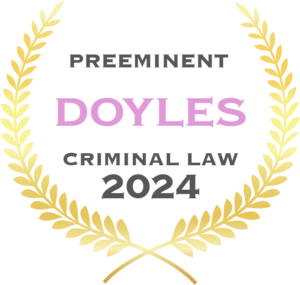If you have pleaded or been found guilty of a criminal offence your matter will progress to sentencing.
The sentence you receive will depend on various factors.
Even if two people have committed the same offence, the penalty that is imposed may differ slightly between offenders.
Most people would be quick to attribute this to judicial discretion, however, contrary to what many people believe, sentencing is a science.
The ‘science of sentencing’ is comprised of two key steps:
- Ascertaining the objective seriousness of the offence; and
- Considering any aggravating or mitigating factors.
The sentencing procedure that the courts must follow is outlined in section 21A of the Crimes (Sentencing Procedure) Act 1999 (NSW) (the Act.
Sentencing proceedings are very complex.
Even if the offence for which you’re being sentenced seems relatively minor, having an experienced criminal lawyer making submissions on your behalf can often be the difference between walking away with a conviction (and criminal record) or convincing the Magistrate or Judge not to record a conviction and ultimately avoiding a criminal record.
Our lawyers are highly experienced and can navigate you through the process to get you the best result in your case.
Step 1: The purpose of sentencing
The sentence imposed must reflect the prescribed purposes of sentencing.
These purposes are outlined in section 3A of the Act, and include things like:
- Ensuring the offender is adequately punished
- General deterrence (i.e. dissuading others in the community from committing the offence)
- Protecting the community
- Promoting the rehabilitation of the offender
- Denouncing the conduct
- Recognising the harm caused to the victim and/or community
Step 2: Alternatives to a custodial sentence?
Next, a judge is obligated to consider all the possible alternatives to a custodial sentence.
Section 5 of the Act outlines that a judge cannot send a person to prison unless it is satisfied that no other penalty is appropriate.
The alternative penalties that are available changed in September 2018. For a detailed discussion of the options that are available, click here.
Step 3: Objective seriousness
A judge is obligated to take into account any ‘factor that affects the relative seriousness of the offence’.
This step is often referred to as the ‘proportionality principle’. It requires the judge to take into account the maximum statutory penalty that may be imposed, the circumstances in which the offence was committed and consideration of an offender’s culpability.
To determine an offender’s degree of culpability, a judge will consider things like the degree of intent or motive behind the commission of the offence.
For example, if you have been charged with fraud, the objective seriousness of the offence may be heightened if you have continued to engage in illegal activity over many years, as opposed to committing a one-off, opportunistic based offence (Agius v The Queen [2015] NSWCCA 200).
Step 4: Aggravating and mitigating factors
Next, the judge will consider any aggravating or mitigating factors.
The presence of aggravating factors will likely increase the severity of your sentence, whereas the presence of mitigating factors will likely lessen the severity.
Aggravating factors include:
- The victim was a police officer, emergency services worker, health worker or teacher (and the offence arose because of the victim’s work)
- The offence involved violence (either actual or threatened)
- The offence involved a weapon, explosive or chemical agent (actual or threatened)
- The victim was drugged
- The offender has a record of convictions
- The offence was committed in company (i.e. in the presence of another person)
- The offence was committed in the victim’s home
- The offence involved a grave risk of death
- The offender abused a position of trust or authority in relation to the victim
- The victim was vulnerable (for example, they were a child or had a disability)
Mitigating factors include:
- The offence was not planned
- The offender was provoked by the victim
- The injury caused was not substantial
- The offender was acting under duress
- The offender does not have a significant record of previous convictions
- The offender is unlikely to re-offend
- The offender has a good prospect of rehabilitation
- The offender is remorseful
- The offender has pleaded guilty
The totality principle
The totality principle is a common law principle that applies in cases where an offender has been convicted of multiple offences.
Adhering to the principle of totality requires a judge to ensure that the overall sentence imposed is a ‘just and appropriate measure of the total criminality involved’.
Therefore, if you are being sentenced for multiple offences, the judge is required to ensure that the penalty imposed reflects the ‘totality’ of your offending.
However, the judge will often allow you to serve your sentence concurrently, meaning the penalty will often overlap.
Key Takeaways
- Sentencing in NSW follows a structured approach focusing on the offense's seriousness and considering aggravating or mitigating factors.
- The process involves assessing the purpose of sentencing, alternative penalties, the crime's objective seriousness, and specific factors that could influence the sentence's severity.
- Legal representation significantly impacts sentencing outcomes, emphasizing the importance of experienced criminal lawyers in navigating the sentencing process.
Have an upcoming sentencing?
If you are going to be sentenced for a criminal offence it is vital to engage experienced criminal lawyers who can make submissions on your behalf.
Our lawyers have extensive experience appearing in sentencing matters and will get you the best result.
For sentencing advice or representation call Hamilton Janke lawyers 24 hours a day, 7 days a week on 4038 1666 or submit an enquiry.
Written By

James Janke
James Janke is founding partner at Hamilton Janke Lawyers, and has more then decade of experience as a Criminal Defence Lawyer. Admitted to both the Supreme Court of New South Wales and High Court of Australia




